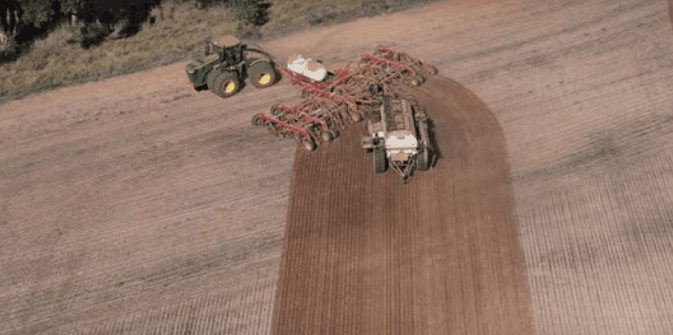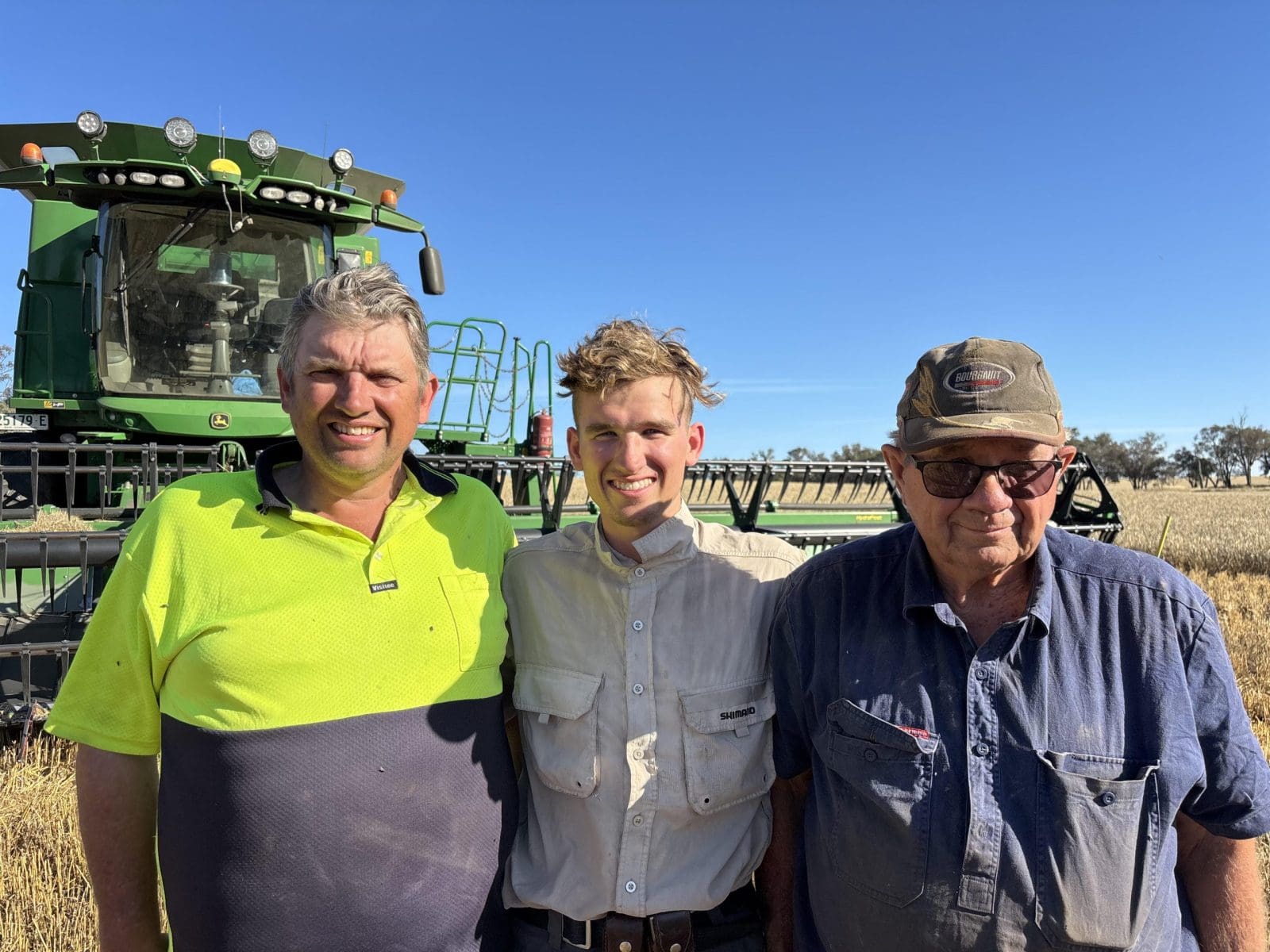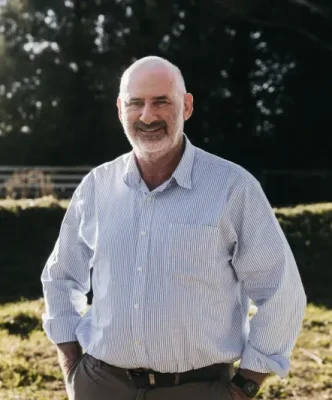
The Norman family’s modified planter was used to plant wheat and canola at the Temora Agricultural Innovation Centre to help gauge the potential of high rates of N applied at planting. Image: FarmLink
THE use of green ammonia as a source of nitrogenous fertiliser is shaping up as a means for broadacre farming in Australia to reduce its greenhouse gas emissions.
Now that Fortescue Future Industries appears highly unlikely to produce green ammonia on Incitec Pivot’s mothballed Gibson Island facility in Brisbane, where it will be made is the question.
While other green ammonia projects are on the drawing board, particularly in Western Australia, University of Melbourne researcher Richard Eckard said their production may well go into abating carbon in the transport and shipping industries.
“I think the real action is going to be on farm using renewable energy like solar and there are already six companies offering technologies in this area,” Professor Eckard said.
Some are only at the capital-raising stage, while others like Nitronic, which is ready to trial production of urea made with renewable energy, are further down the track.
In eastern Australia, the Good Earth Green Hydrogen and Ammonia project is a front runner.
Known as GEGHA, it was last year awarded $35.8 million from the New South Wales Government, and involves the Statham family’s Sundown Pastoral Co, as well as New Zealand company Hiringa Energy.
At Illabo in NSW’s eastern Riverina, the Norman family is working with Temora-based research organisation FarmLink in trialing higher rates of up-front nitrogen that can minimise the need for top-dressing with urea made from fossil fuels.
As long-time users of anhydrous ammonia, the Normans are getting ready to use chemically identical ammonia from the GEHGA project in coming years, and have set up Clean Green Ag to work with FarmLink, and green ammonia once it becomes available commercially.
Promising results from FarmLink trial
Sundown is a leading grower of cotton in northern NSW, and the GEGHA project is being built on Keytah, its 26,300ha property west of Moree.
Clean Green Ag is hoping to have access to GEHGA green ammonia, and in the meantime will continue to use anhydrous ammonia on its 1700ha of winter cereals and canola.
As NH3, it will be chemically identical to anhydrous ammonia as applied with the Norman’s modified planter to place nitrogen at depth is being used in FarmLink’s three-year Decarbonised Farming project, which started last year.
“The trials use our commercial gear, and the project has been set to find out what it would look like to sow with green ammonia, which is 82-83 percent nitrogen, against urea at 46pc,” Tom Norman said.
“Because green ammonia will be carbon neutral, we want to use as high a rate as we can to front-load the nitrogen at the start of the season.”

Three generations of Normans on the farm at Illabo: Tom with his father Murray, and Murray’s father Ray, on their last day of harvest 2024.
On the family farm, the Normans drill 120kg of NH3 per ha, which equates to 260kg of urea, and 70kg/ha of MAP, some drilled and some up top, at sowing.
The trial, at FarmLink’s Temora Agricultural Innovation Centre, sowed 250ha of wheat and canola with 100kg/ha of NH3 at sowing, equivalent to 82kg/ha of nitrogen, or 178kg/urea.
This is well above usual rates of around 100kg/ha of urea at sowing, with additional amounts applied as required, and calculated around forecast in-crop rain.
In addition to 50kg/ha of MAP at sowing, crops in the FarmLink trial were top-dressed with 60kg/ha of urea, while trial plots at TIAC were grown on differing rates of NH3 and urea, alone or in combination.
The Prime Hard wheat variety sown for the commercial trial saw more than half the harvested 2023-24 tonnage grade APH of minimum 14pc protein, with the balance making H2 of minimum 11.5pc protein, and the overall wheat yield averaged 3.7t/ha, despite the extremely dry finish.
Using high levels of NH3 at sowing is seen as a way to minimise the need to top-dress during the growing season.
As FarmLink’s project summary states: “We see potential in using high rates of ammonia at sowing as the basis for an N-banking strategy. Instead of chasing changing yield potentials midyear with urea, we will maintain high soil N levels with up-front ammonia.
This will take the guesswork out of weather forecasts, remove logistical bottle necks associated with sourcing urea mid-season and, in the future, allow us to offset more GHG emissions by using less fossil fuel-derived fertilisers.”
Long links to gas
Tom Norman is a fifth-generation farmer at Glenbrook in the Illabo region, between Cootamundra and Junee, where anhydrous ammonia was first used in the 1990s by Tom’s grandfather Ray Norman.
Ray’s marriage to Beverley brought him to the farm taken up by the her family, the Stanyers, in 1909, which Tom said was incidentally the same year the Haber-Bosch process was developed to turn nitrogen and hydrogen gas into ammonia.
It remains the primary process by which the world’s urea, the most common form globally of nitrogen applied before and during sowing, and during the growing season as needed to maximise yield potential.
“Pop was one of the leaders around here in using anhydrous after he saw it in Queensland, and then in America,” Tom said.
“We have a special air seeder that Pop has modified so that we can put a large amount of gas below and beside the seed.”
While Tom’s parents Murray and Rachel Norman are in Sydney, where Tom grew up, Ray and Beverley are still on the farm, where land use is split equally between cropping canola, wheat, barley, and faba beans, and a self-replacing flock of 4500 Merino ewes, plus first-cross lambs.
The family’s willingness to embrace change is embodied in Tom, a Charles Sturt University Agricultural Science graduate who is one of EvokeAg’s Groundbreakers, and will be talking about the FarmLink trial and Clean Green Ag at EvokeAg in Brisbane in February.
He recounts a family adage in relation to being proactive about the need to lower emissions: “The best time to fix a hole in the roof is before it starts raining”.
“There’s not going to be a silver bullet, but CSIRO and GRDC research showed green ammonia could be a solution.”
Nitronic sparks interest in west
In WA, a process developed at the University of Illinois caught the eye of WA-based researcher Stuart Gunzburg in his search for a means of making carbon-neutral fertiliser in Australia.
As the co-founder and managing director of Nitronic, Dr Gunzburg has spent five years on developing the process into one which can be commercialised, and the design of a pilot plant is his latest task at hand.
“I’ve had so many farmers wanting to put it on their farm,” Dr Gunzburg said.
Nitronic is looking at having a number of plants making products including urea, sulphate, and phosphate dotted throughout the grainbelt to supply clusters of growers.

Nitronic’s Dr Stuart Gunzburg.
“Units will be producing 2-5 tonnes a day in flick-on, modular units with 10,000-litre tanks with associated power generation.
“It’s something that can fit inside a big shed.”
The process involves room-temperature and low-pressure plasma technology which combines solvent with acid.
“Ammonia’s only a halfway step to producing fertiliser, and I developed the back-end design,” Dr Gunzburg said.
Dr Gunzburg said Nitronic’s urea could be coated with nitrification inhibitors or other compounds to suit the customer’s needs for a variety of crops, including cotton and wheat.
The company has already caught the attention of agrifood investment vehicle SparkLabs Cultiv8.
Other technologies are also being developed around the world, and include:
Nitrofix: An Israeli start-up making ammonia through a novel electrochemical process.
ReMo: Based in Boston in the US, ReMo uses renewable energy to make ammonia with a fleet of plants;
Starfire Energy: Based in Colorado in the US, it aims to make ammonia using renewable energy. Its RapidRamp NH3 plants are built in shipping containers and offer economies of scale. Investors in Starfire Energy include Samsung and Mitsubishi.
Jupiter Ionics: Developed at Melbourne’s Monash University, it uses the patented wind and solar-powered MacFarlane Simonov Ammonia Cell electrochemical process to make ammonia.
Nitricity: Based in California, Nitricity uses air, water, renewable energy and almond shells to make a liquid fertiliser through a thermal plasma process.

HAVE YOUR SAY